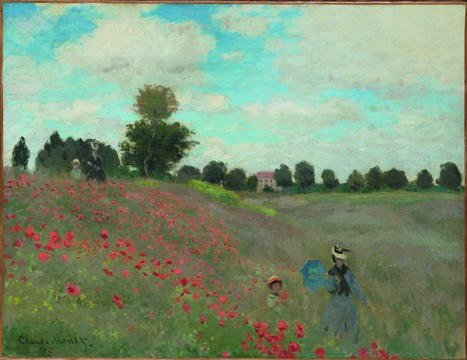Claude Monet 1840–1926

With some 200 paintings gathered from more than 70 international museums and private collections, the Monet retrospective opening today at the Grand Palais in Paris is a glorious tribute to the grand master of Impressionism. Even art lovers who think they know Monet’s work well are in for a surprise at the overwhelming effect of so many of his major works all in one place at the same time—again and again, throughout the show, light seems to emanate from the paintings themselves, radiating from some inner source.
The young Monet tried his hand at everything—still lifes, portraits, genre paintings and historic scenes. But his true field was landscapes and seascapes, and no matter where he set up his easel in the great outdoors, his subject was light and its fleeting, ephemeral, dancing, shimmering, infuriatingly elusive effects. He spent his long, prolific career trying to capture it, calling his pursuit of subjects in Normandy or the countryside around Paris “campaigns”, in the military sense—and often returning home after a day’s work drenched, or frozen. Once, when asked where his studio was by a visiting journalist, he gestured to the surrounding fields, “Voila mon studio à moi!” For a time in the 1870s, he even set up a floating studio in a small boat as he worked mid-stream in the Seine. (Manet painted him at work on it in 1873.)
The first half of the show is a partly chronological tour de France, focusing on the regions he painted, from the forest of Fontainebleau and the Normandy of his childhood to the countryside around Paris; the street and squares of the city itself and the steam engines of its smoke-filled railroad stations; the “terrible wildness” of the Brittany coast and the palm gardens and blue skies of the Mediterranean, where he said he needed “a palette of diamonds and precious stones”.
The second half is thematic—still lifes, figures and portraits, and most importantly the series of identical subjects painted over and over in ever-changing light: haystacks in the fields near his home in Giverny, stands of poplars, Rouen Cathedral, mornings on the Seine and—campaigning farther afield—the Thames and the Houses of Parliament in London’s light-refracting fog, and the palaces floating in the mist on Venetian canals.
The show ends with only a few of the Water Lilies that occupied the final years of the artist’s life, but the principal water-lily panoramas are to be seen, as Monet intended them to be, in their permanent home at the Musée de l’Orangerie in the Tuileries Gardens. And, to complete the Grand Palais exhibit, starting on October 7 the Musée Marmottan Monet, in Paris’s 16th arrondissement, will be showing all 136 paintings of its Monet collection, the largest in the world.
Claude Monet 1840–1926, Grand Palais, Ave Winston Churchill, Paris 8th, Sept 22–Jan 24. www.monet2010.com
Claude Monet, Son Musée, Musée Marmottan Monet, 2 rue Louis Boillly, Paris 16th, Oct 7–Feb 20. www.marmottan.com
Les Nymphéas, Musée de l’Orangerie, Tuileries Gardens Paris 1st, permanent. www.musee-orangerie.fr
Share to: Facebook Twitter LinkedIn Email
Leave a reply
Your email address will not be published. Required fields are marked *



